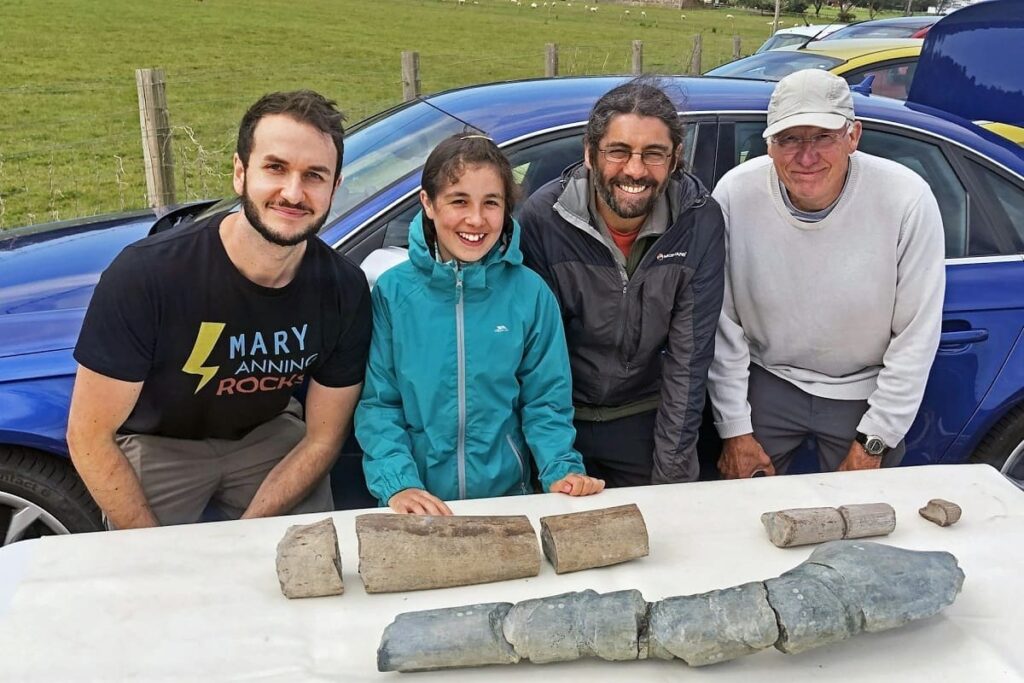Imagine walking along a beach in Somerset, UK, and stumbling upon something that looks straight out of a prehistoric film—a jawbone so large it could easily be mistaken for a relic from a Jurassic Park movie. This isn’t a scene from a blockbuster; it’s a remarkable real-life discovery that has helped reshape our understanding of marine life from millions of years ago.
The Discovery in Somerset
The story of this fascinating find begins eight years ago when fossil hunter Paul de la Salle discovered a massive, oddly shaped jawbone on the coast of Lilstock, Somerset. Although it was clear that the fossil belonged to a giant marine reptile, the incomplete jawbone raised questions. Without additional evidence, scientists, including de la Salle, hesitated to declare the creature a new species. But as they say, patience is a virtue—and in 2020, the pieces of the puzzle finally fell into place.
That year, amateur fossil hunters Justin Reynolds and his 11-year-old daughter Ruby uncovered another jawbone just a few kilometers away from the original site. This new find sparked a collaboration between professional and amateur paleontologists, leading to an exciting scientific breakthrough that was recently published in the journal PLOS One.
Identifying a New Giant
The team, combining seasoned professionals with passionate amateurs, worked tirelessly to piece together the two jawbones. They discovered that while the fossils came from different individuals, they shared a common timeline, and both belonged to the same giant marine reptile species. Through extensive research and comparisons with other ichthyosaur specimens, they concluded that they had discovered not only a new species but a whole new genus. They named it Ichthyotitan severnensis, which translates to “giant fish of the Severn,” named after the nearby Severn River.
Estimates suggest that Ichthyotitan severnensis reached a staggering 26 meters in length—roughly the size of a blue whale. This size was determined using standard scaling methods employed in paleontology, despite the fact that only the jawbones were found. The distinctive features of the fossils were enough to set this creature apart from other marine reptiles of its time.
Giants of the Marine World
Imagine the enormity of a creature as long as a blue whale but swimming through waters that once covered what is now the British Isles. The sheer size of Ichthyotitan severnensis makes it one of the largest known marine reptiles of its era. This discovery provides not just a glimpse into an ancient world of gigantic creatures but also highlights the diverse life forms that once inhabited Earth’s oceans.
What’s even more significant is the timing of this discovery. Ichthyotitan severnensis lived just a few million years before the Triassic mass extinction, an event that changed life on Earth. Scientists believe this event, likely triggered by volcanic activity, led to a dramatic spike in carbon dioxide levels, wiping out many species, including marine reptiles like Ichthyotitan.

The Role of Community in Paleontology
What makes this discovery even more remarkable is the involvement of the local community—specifically, Ruby Reynolds. Despite not having formal training in paleontology, Ruby, along with her father, made a crucial contribution to this groundbreaking discovery. As a teenager, she helped identify and understand the significance of this fossil, an achievement that was officially recognized in scientific circles. Ruby’s involvement underscores the importance of community participation in science, proving that anyone with an eye for detail and a little bit of luck can contribute to major discoveries.
This also serves as a reminder that science isn’t just for seasoned experts. It’s for anyone with curiosity, enthusiasm, and a willingness to dive into the unknown.
Reflections on the Giants of the Past
It’s awe-inspiring to imagine these giant marine reptiles, comparable in size to today’s largest mammals, once swimming in the ancient seas that once covered parts of the UK. The fossils provide not just a glimpse into the distant past but also a powerful reminder of the mysteries still hidden beneath the Earth’s surface. As we continue to explore the planet’s history, discoveries like this one remind us that the world is full of secrets waiting to be uncovered.
This discovery not only adds a fascinating new chapter to the study of marine paleontology but also serves as a testament to the enduring mystery of the natural world, where everyday people like Ruby can make a huge difference. It’s a story of unexpected adventure and a glimpse into the prehistoric giants that once roamed our oceans.






